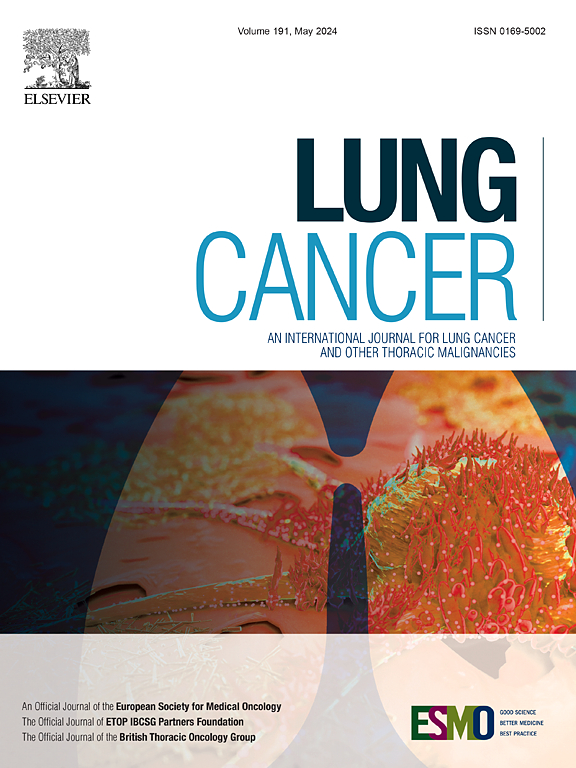TKI耐药后egfr突变NSCLC的免疫治疗:突变亚型和进展模式的作用
IF 4.4
2区 医学
Q1 ONCOLOGY
引用次数: 0
摘要
背景:非小细胞肺癌(NSCLC)中egfr致敏突变的患者主要接受一线酪氨酸激酶抑制剂(TKIs)。随后的TKI耐药表现为异质的临床病理特征,包括不同的耐药亚型(原发性和获得性)、PD-L1表达水平和再活检的分子谱。虽然免疫疗法代表了一种潜在的后续选择,但指导最佳患者选择的预测性生物标志物仍然不明确。患者和方法本多中心回顾性研究分析了来自中国5家机构的1396例egfr突变型非小细胞肺癌患者,其中312例符合严格的纳入标准。收集了包括EGFR-TKIs、铂基化疗、抗血管生成药物和免疫检查点抑制剂(ICIs)在内的综合治疗数据。Cox比例风险回归确定了无进展生存期(PFS)相关变量,从而实现了耐药亚型。进行了不同治疗方式的比较效果分析。结果多变量Cox回归确定了免疫治疗PFS的两个独立预测因子:EGFR突变亚型(exon21 L858R vs. exon19del;HR 0.84, 95% CI [0.70-0.99], P = 0.042)和TKI耐药分类(获得性vs原发性:HR 2.28, 95% CI [1.52-3.43], P = 0.001)。原发TKI耐药患者接受ICIs治疗后的预后有所改善(中位PFS为8.5 vs 4.0个月;HR 0.46, 95% CI [0.29-0.76], P = 0.002),尤其在l858r突变亚组中。相比之下,获得性耐药队列,特别是外显子19del突变的队列,临床获益有限(HR 1.09, 95% CI [0.84-1.42];p = 0.510)。这些发现表明,耐药亚型和突变谱可能有助于egfr突变型NSCLC的免疫治疗选择,需要通过前瞻性研究进行验证。这项多中心分析表明,TKI失败后EGFR突变型NSCLC的免疫治疗结果受到耐药亚型(原发性vs.获得性)和特异性EGFR突变谱(L858R vs. exon19del)的影响。原发性耐药和L858R突变的患者从ICIs中获得了临床意义上的益处,而获得性耐药的患者,特别是外显子19del变体,疗效有限。这些发现支持在前瞻性试验中进一步研究耐药表型引导的治疗算法,以优化治疗测序策略。本文章由计算机程序翻译,如有差异,请以英文原文为准。
Immunotherapy in EGFR-mutant NSCLC after TKI resistance: role of mutation subtypes and progression patterns
Background
Patients with EGFR-sensitizing mutations in non-small cell lung cancer (NSCLC) predominantly receive first-line tyrosine kinase inhibitors (TKIs). Subsequent TKI resistance manifests through heterogeneous clinicopathological features, including distinct resistance subtypes (primary vs. acquired), PD-L1 expression levels, and molecular profiles from re-biopsies. While immunotherapy represents a potential subsequent option, the predictive biomarkers guiding optimal patient selection remain undefined.
Patients and methods
This multicenter retrospective study analyzed 1,396 EGFR-mutant NSCLC patients from five Chinese institutions, with 312 meeting stringent inclusion criteria. Comprehensive treatment data encompassing EGFR-TKIs, platinum-based chemotherapy, anti-angiogenic agents, and immune checkpoint inhibitors (ICIs) were collected. Cox proportional hazards regression identified progression-free survival (PFS)-associated variables, enabling resistance subtyping. Comparative effectiveness analyses across therapeutic modalities were performed.
Results
Multivariable Cox regression identified two independent predictors of immunotherapy PFS: EGFR mutation subtypes (exon21 L858R vs. exon19del; HR 0.84, 95 % CI [0.70–0.99], P = 0.042) and TKI resistance classification (acquired vs. primary: HR 2.28, 95 % CI [1.52–3.43], P = 0.001). Patients with primary TKI resistance showed improved outcomes with ICIs (median PFS 8.5 vs. 4.0 months; HR 0.46, 95 % CI [0.29–0.76], P = 0.002), particularly in L858R-mutant subgroups. In contrast, acquired resistance cohorts—especially those with exon19del mutations—derived limited clinical benefit (HR 1.09, 95 % CI [0.84–1.42]; P = 0.510). These findings suggest that resistance subtype and mutation profile may aid immunotherapy selection in EGFR-mutant NSCLC, requiring validation through prospective studies.
Conclusions
This multicenter analysis demonstrates that immunotherapy outcomes in EGFR-mutant NSCLC after TKI failure are influenced by both resistance subtypes (primary vs. acquired) and specific EGFR mutation profiles (L858R vs. exon19del). Patients with primary resistance and L858R mutations derive clinically meaningful benefit from ICIs, while those with acquired resistance, particularly exon19del variants, showed limited efficacy. These findings support further investigation of resistance-phenotype-guided therapeutic algorithms in prospective trials to optimize treatment sequencing strategies.
求助全文
通过发布文献求助,成功后即可免费获取论文全文。
去求助
来源期刊

Lung Cancer
医学-呼吸系统
CiteScore
9.40
自引率
3.80%
发文量
407
审稿时长
25 days
期刊介绍:
Lung Cancer is an international publication covering the clinical, translational and basic science of malignancies of the lung and chest region.Original research articles, early reports, review articles, editorials and correspondence covering the prevention, epidemiology and etiology, basic biology, pathology, clinical assessment, surgery, chemotherapy, radiotherapy, combined treatment modalities, other treatment modalities and outcomes of lung cancer are welcome.
 求助内容:
求助内容: 应助结果提醒方式:
应助结果提醒方式:


